One of the chief reasons why we can boondock (camp off-grid) for as long as we do is the ability of our substantial solar array to harness the awesome power of the sun to keep our electrical system running wherever we are. But we’re full-timers (and we’ve been so for very nearly two decades) and we live and work on the road from our RV, so we need lots of power. Not everyone needs a massive solar array with multiple solar panels and a panel tilting system installed on the roof of their rig, and not everyone is interested in the time, effort, and expense needed to install a setup like ours. Fortunately, there are portable solar panels for RVs now, and the technology behind these panels has improved tremendously.
This means that keeping your RV battery bank charged and using the power of the sun to tend to your electrical needs when you’re camping off the grid has never been easier.
In today’s post, we’re taking an in-depth look at portable solar panels. What exactly are they and how do they work? Can you toss a couple of portable solar panels in your RV and power your rig with the sun when you reach your destination? It’s not quite that simple, but close!
Let’s dig into the ins & outs and the pros & cons of portable solar panels for RVs.
- 1) What Is a Portable RV Solar Panel?
- 2) Polycrystalline vs. Monocrystalline Solar Panels
- 3) What Are the Advantages of Portable Solar Panels For RVs?
- 4) What Are the Disadvantages of Portable Solar Panels for RVs?
- 5) What Size Portable Solar Panel Do I Need to Charge My RV Battery?
- 6) What Can I Run With a 100 Watt Portable Solar Panel?
- 7) What Will a 200 Watt Solar Panel Run?
- 8) How Do I Connect My Portable Solar Panel to my RV?
-
9)
What Are the Best Portable Solar Panels for RVs?
- 9.1) Zamp Solar Legacy Series 140-Watt Portable Solar Panel Kit (with Integrated Charge Controller and Carrying Case)
- 9.2) Renogy 100 Watt Eclipse Monocrystalline 20A Voyager Solar Suitcase With Waterproof Controller
- 9.3) Renogy 200 Watt Off-Grid Portable Foldable Solar Panel Suitcase Waterproof 20A Charger Controller and Built-In Kickstand
- 9.4) ECO-WORTHY 120W Foldable Solar Panel Kit for Portable Generator Power Station, with USB Controller to Charge 12V Battery
- 9.5) Xantrex 100W Solar Power Portable Flex Kit
- 10) Are Portable Solar Panels Worth It?
What Is a Portable RV Solar Panel?
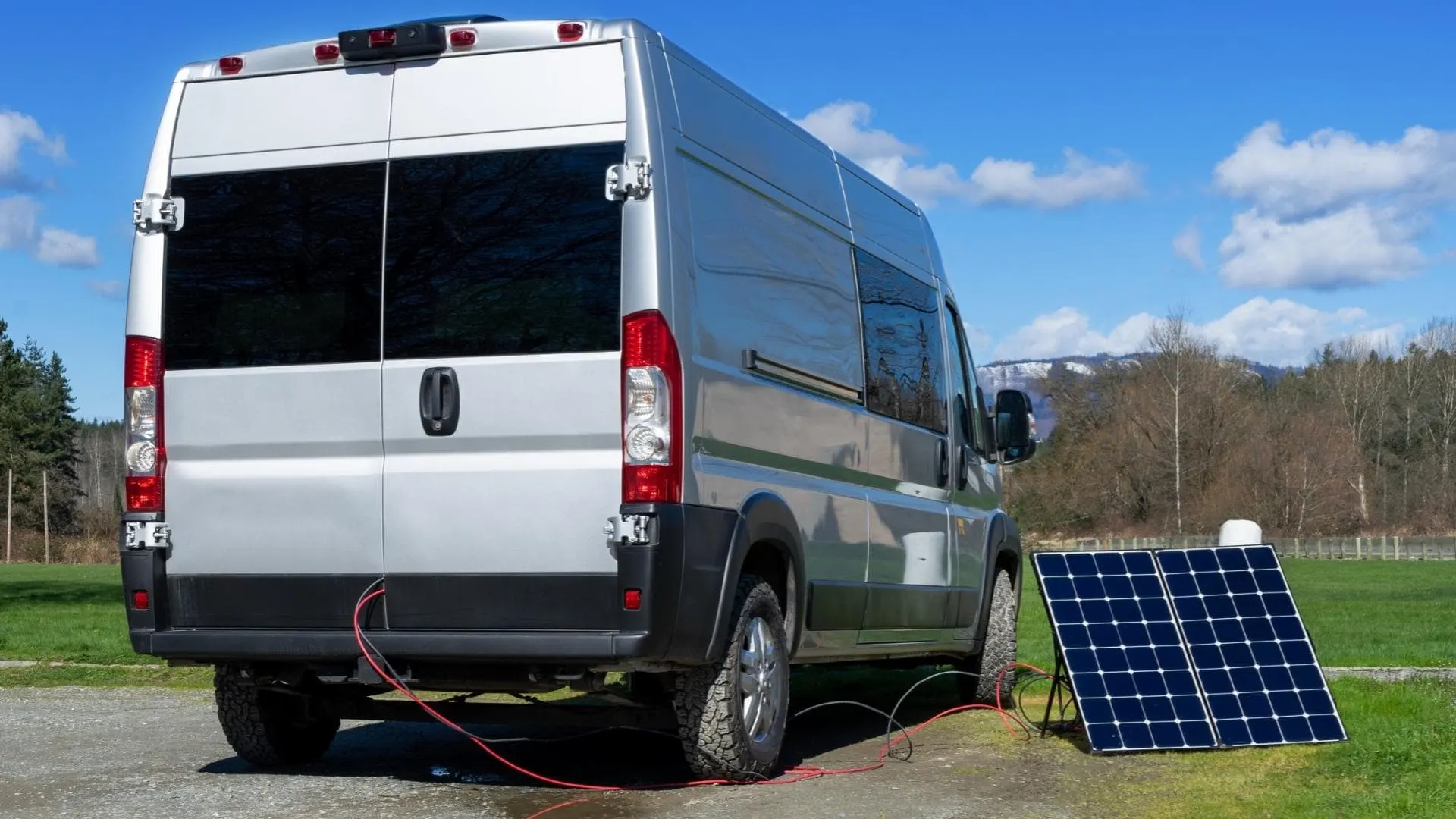
Portable solar panels are carried inside your RV while you’re traveling and can be set outside in the sun when you’re camping.
A portable RV solar panel is very similar to a solar panel you see installed on the roof of an RV except that it’s able to be moved from place to place, and is stored in your RV for travel and when not in use.
Portable RV solar panels usually have MC4 connectors (or similar) which allow them to be very easily connected to a charge controller… which is in turn connected to your RV’s 12V house battery/battery bank (often by large alligator clamps, like for automotive jumper cables).
Like mounted solar panels, a portable RV solar panel may be polycrystalline or monocrystalline.
Polycrystalline vs. Monocrystalline Solar Panels
Polycrystalline panels can be identified by their lighter blue color. The process used to make polycrystalline silicon is a simpler process, making these panels less costly to produce, and thus less expensive to buy. However, they’re also slightly less efficient than monocrystalline solar panels.
Monocrystalline panels can be identified by their darker blue/black color. These panels are not only more efficient at generating power, but (as a result) more space-efficient because they’re smaller. Monocrystalline panels are more expensive than polycrystalline panels.
What Are the Advantages of Portable Solar Panels For RVs?
There are a number of advantages to using portable solar panels for RVs. Let’s take a look at some of their benefits.
No Installation
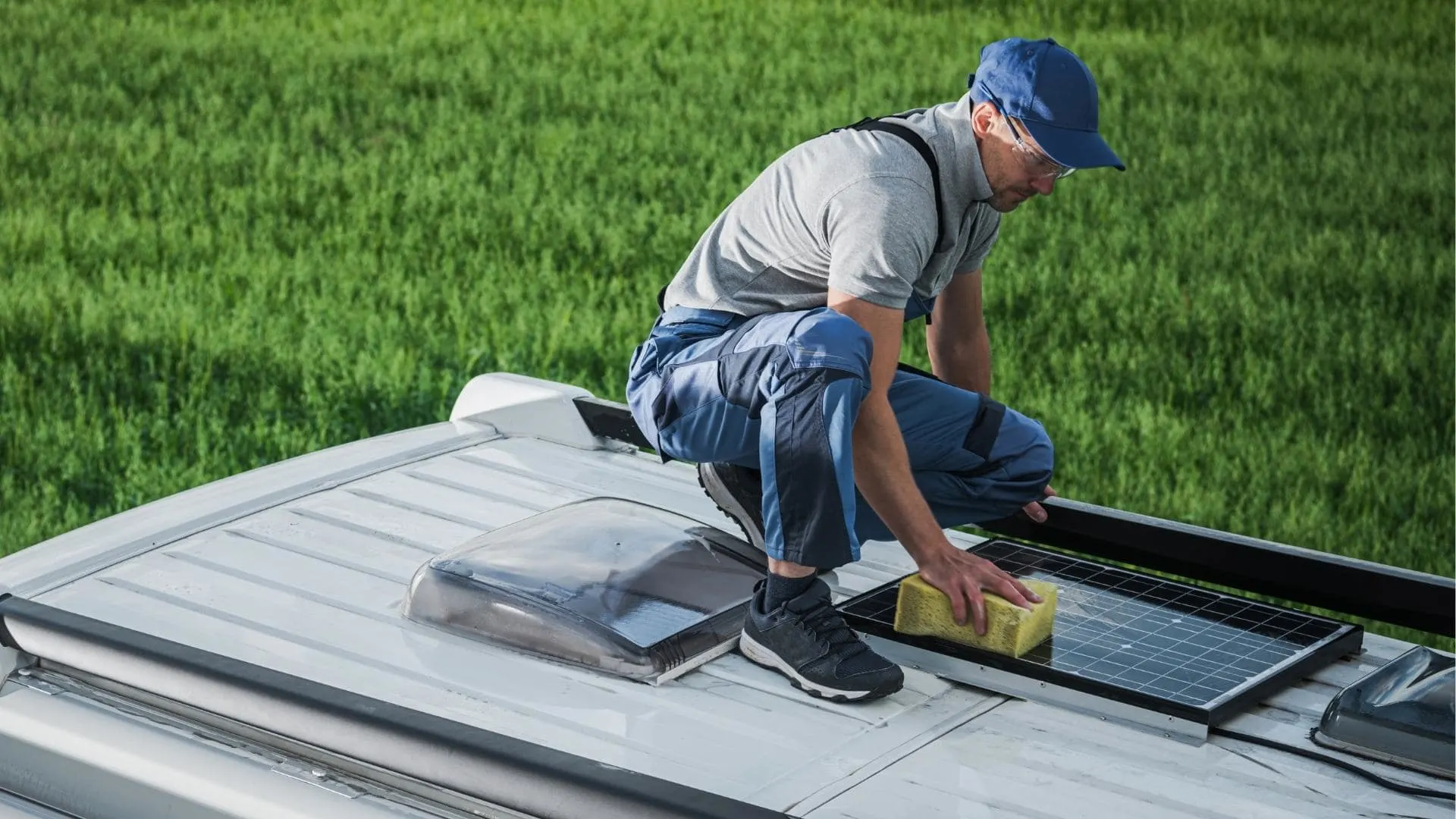
With portable solar panels, there’s no need to get up on the roof of your rig for installation or cleaning purposes.
There’s no installation necessary with a portable solar panel. No holes need to be drilled into the roof of your RV for mounting hardware or to run cords through to the charge controller. No need to even get up on the roof at all.
Portable RV panels don’t need to be installed – they simply need to be placed in the sun and connected.
Portability
One of the great benefits of portable RV solar panels is the fact that they can be moved to wherever the sun’s light is most prominent. When the sun moves, the panels can be easily moved to follow it to continue to best capture the power of the sun.
In fact, your RV can be parked in the shade on a hot day, and your portable RV solar panels can be placed in the sun. With panels that are installed, you either have to park your rig in the sun or you’re not harnessing its greatest power.
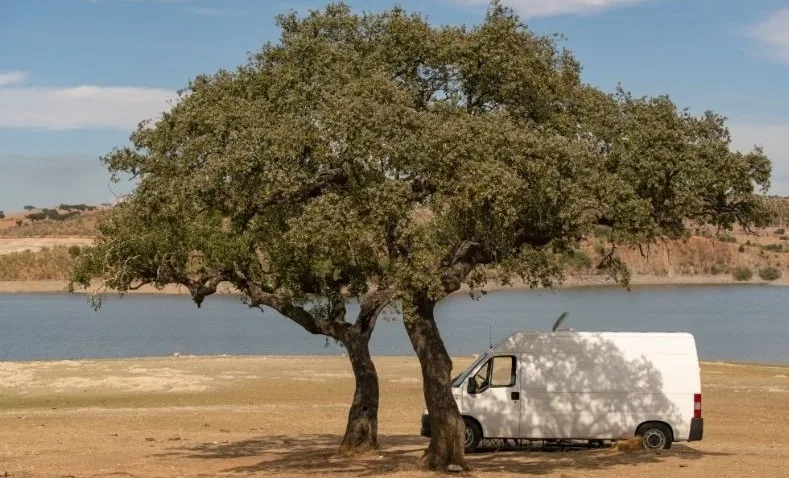
With portable solar panels, you can park your rig in the shade on a hot day, while leaving your solar panels out in the bright sun.
May Have USB Ports to Charge Devices Directly
Some portable solar panels for RVs have built-in USB ports that allow you to charge devices directly from the panel itself. This can be very handy for charging a phone or tablet while the panel is also charging your RV’s battery bank.
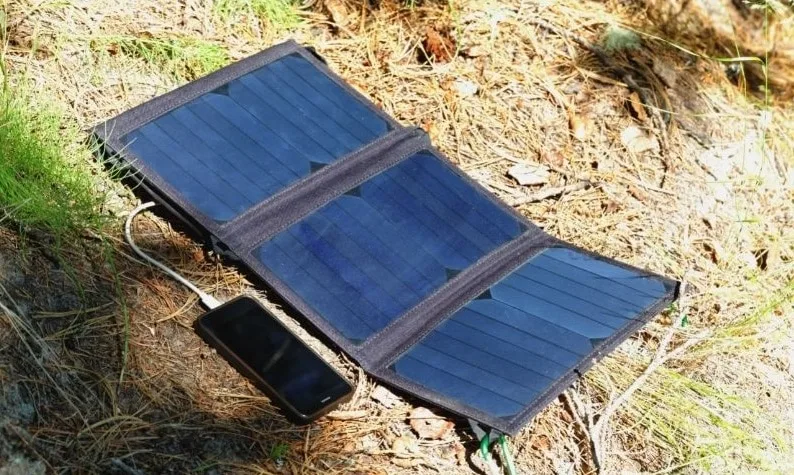
Some solar panels have USB ports for direct charging of small devices like cell phones and tablets.
Can Easily Connect to a Solar Generator for a Compact Power Station
A common use of portable solar panels is to connect them directly to a compact solar generator (a portable device containing a battery for storing power and often a small inverter for powering a 120V AC outlet), forgoing the need to deal with batteries and a charge controller. Many folks who travel in vans that are self-built RVs buy a solar generator and some portable solar panels instead of installing an entire electrical system.
A solar generator can be useful for charging many devices and appliances. Depending on the capacity of the solar generator, it can power laptop computers, small gaming devices, lights, a television, a CPAP machine, and/or a small 12V refrigerator.
There are larger solar generators that are capable of running more power-hungry appliances like hair dryers, microwave ovens, and other larger appliances.
What Are the Disadvantages of Portable Solar Panels for RVs?
While portable solar panels have many advantages, there are a few disadvantages to consider when deciding whether to invest in portable solar panels for your RV.
Expensive
In general, portable solar panels are more expensive than solar panels that are intended to be installed (although that may be more than made up for by the lack of installation expense).
This is an expense some folks are willing to accept in exchange for a system that they can buy and use instantly without needing to consider the issues related to a more complicated installation.
Can Be Heavy
With portable solar panels, you have to remember that you’ll be moving them into and out of your rig over and over again, and moving them from place to place to take advantage of the sun.
Some portable solar panels can be quite heavy, so that should be taken into consideration as you’re shopping for the right portable system for you.
There are very small solar panels that don’t weigh much at all – in fact, we’ll feature a nice little 100 Watt folding solar panel at the end of this post that only weighs four pounds, and another that weighs in at only nine pounds. But you may be limited to 100 Watts or so with these very lightweight panels, so you’ll need to keep this balance in mind as well.
Require Setup/Breakdown At Each Site
When we roll into a new campsite, the most we need to do where our solar panels are concerned is to hit a button to tilt our rigid panels toward the sun. When we leave to move to a new campsite, the only thing we might need to do is hit that same button to return the rigid panels to their flat position.
When you’re using portable solar panels for your RV, every time you move you have to break down and store your solar array. When you arrive at a new site, you have to set them up again. This may not be a big deal at all for some folks, while for others it may be burdensome and/or a deal-breaker.
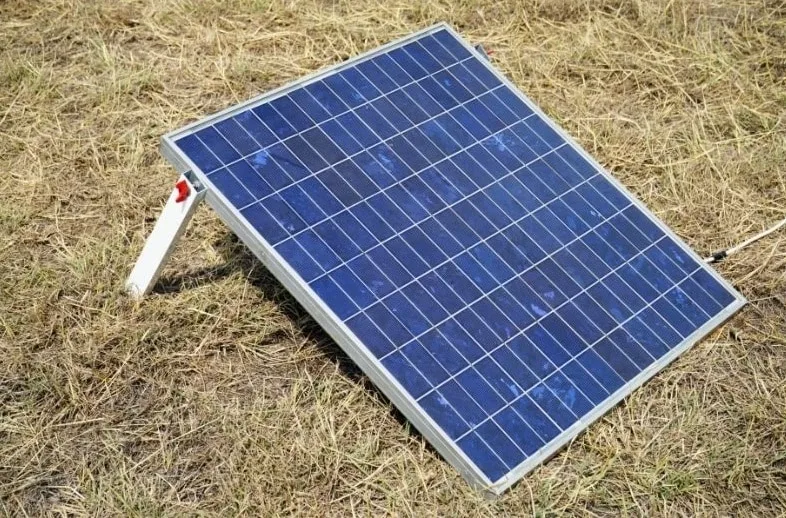
Rigid portable solar panels can be heavy and need to be set up and then collapsed and stored over and over again.
Need to Store Them When Not In Use
When your panels aren’t in use (for example when you’re traveling), you need to have room to store them. Depending on the type of portable panels you buy, this could require a fair amount of space.
A small folding solar panel isn’t a big deal to store away for travel. But larger rigid panels have to travel somewhere, and depending on the size of your rig, they could take up your entire basement storage… or even the hallway in the RV itself.
So, when shopping for a portable solar system, be sure to consider how you’ll store the panels for travel.
Possibility of Theft
Portable solar panels can be stolen, particularly when you’re not around. Many people break down their portable solar system and put the panels away if they leave camp to hike or explore (exacerbating the issue of setup/breakdown for use). This means that your RV’s house battery bank isn’t charging while you’re away.
If you leave your solar panels out, you need to be cognizant of the fact that they could be stolen.
This could depend on where you’re camping, of course. But, portable solar panels are a desirable commodity and are also expensive to replace.
Now that we’ve sorted through the pros and cons of portable solar panels for RVs, let’s take a look at some common questions about RV solar systems.
What Size Portable Solar Panel Do I Need to Charge My RV Battery?
This is a difficult question to answer definitively because there are a number of variables to be considered where solar is concerned. First, there’s the size of your battery bank and how much power you use, and then there’s the unpredictable variable of the sun itself. But we can address this question in generalities.
You might think that a 100 Watt solar panel will generate 100 Watts of power, but that’s not so because there are a variety of factors that will impact the amount of solar power your panels will actually produce. These include cloud cover, time of day, location, and ambient temperature. Even pollution and ozone play a role.
However, there’s a rule of thumb that experts use which says that in general, a 100 Watt solar panel will generate around 30 amp-hours per day. This means that on average, your 100 Watt solar panel will put around 30 amp-hours per day back into your battery bank.
Next, you’ll need to calculate your power usage. Then, remember that your goal is to have your power input come as close as possible to matching about 2x your daily power output/consumption (which helps to make up for less power provided on a cloudy/rainy day when the sun comes back out).
If you find that you generally consume around 30 amp-hours per day, remembering the general rule of thumb, a 100 Watt panel will give you around 30 amp-hours per day, so you’ll want either a 200 Watt solar panel or a pair of 100 Watt solar panels.
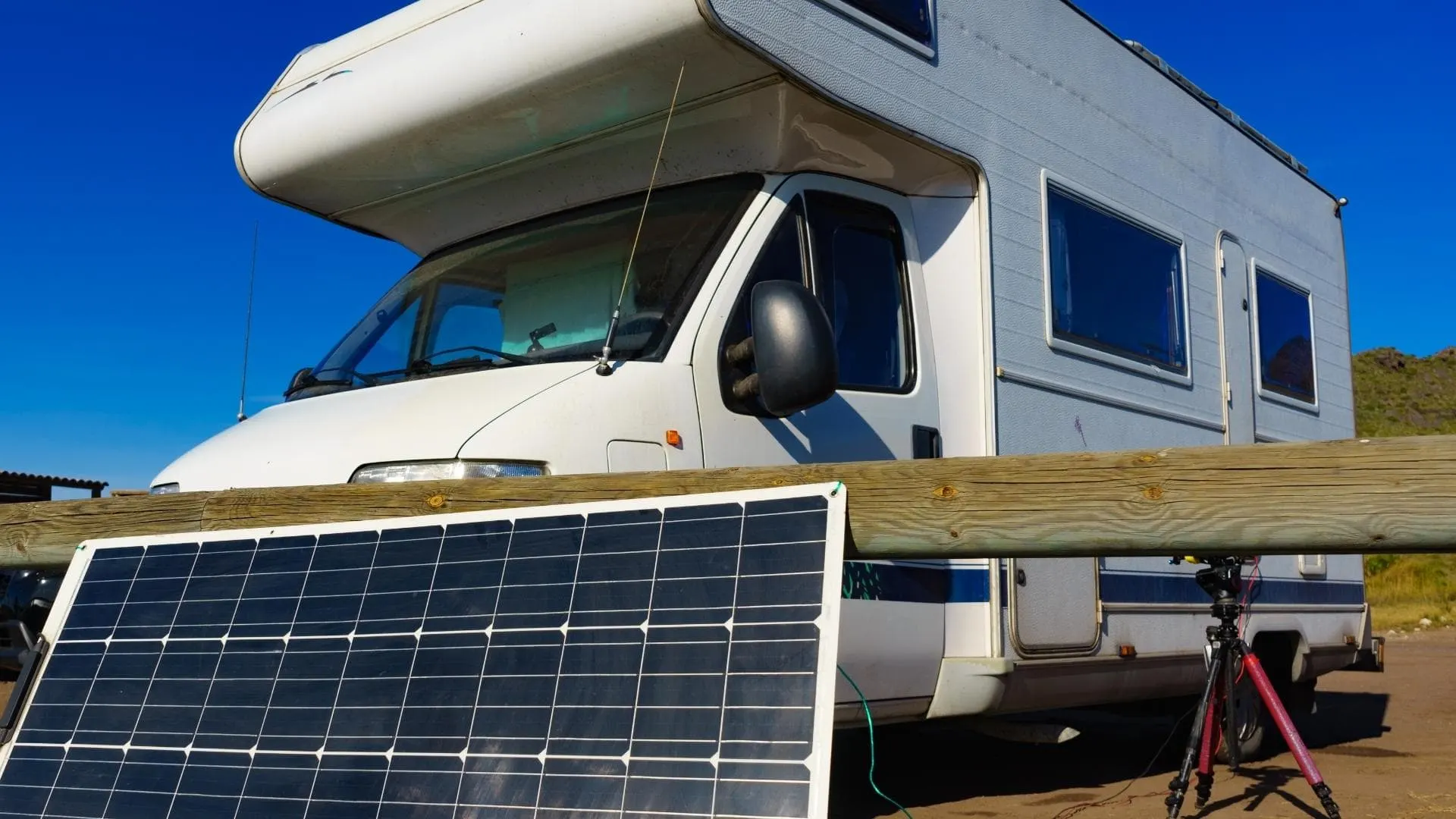
Different wattages of solar panels will charge your battery bank at different rates. That’s why a 200 Watt panel will allow you to run more power-intensive appliances than a 100 Watt panel will allow.
What Can I Run With a 100 Watt Portable Solar Panel?
First of all, we don’t generally run a device or appliance with a solar panel (unless the portable panel has USB inputs to run small devices). The solar panel inputs energy/power into your battery bank (not directly but through a charge controller), and this is how the battery bank is charged to run your devices and appliances.
So, what this question really asks is how fast (and also how efficiently) a 100 Watt solar panel can recharge your battery bank as you use power from it.
With that in mind, we can offer some generalizations, but the real answer will depend on a number of variables including the nature of your electrical system/battery bank, the devices you’re running, how long you run them, how much sun the panels get, as well as several other variables.
Generally speaking, if you have a 100 Watt portable solar panel, your battery bank will likely be charged sufficiently to power small, low-power-draw devices such as your cell phones, RV lights, vent fan/Fantastic fan, tablets, small battery packs, and even your water pump – for variable amounts of time.
What Will a 200 Watt Solar Panel Run?
A 200 Watt solar panel will charge your battery bank sufficiently to run all of the above noted for the 100 Watt panel (for longer), and you’d also be able to run small appliances such as a coffee maker and a hairdryer if you have an inverter (though not for extended periods of time).
How Do I Connect My Portable Solar Panel to my RV?
This isn’t complicated, but there is a piece of information that’s critical to the process of connecting a portable solar panel to your RV.
A solar panel shouldn’t be connected directly to a battery. A solar panel would apply too much voltage and/or current to the battery which could eventually overcharge and damage the battery.
Between the solar panel and the battery, you need a solar charge controller. The purpose of a solar charge controller is to regulate the voltage and current coming from the solar panel/panels going to the battery/batteries, providing the proper charge cycle, voltage, and current to properly (and safely) charge your battery (based on it’s chemistry).
So, to connect your portable solar panel to your RV, you’ll need to connect the solar panel to the solar charge controller and connect the solar charge controller to the battery.
Now your portable solar panel will be charging your battery/batteries.
What Are the Best Portable Solar Panels for RVs?
There are many good portable solar panels on the market, but here are five of the best based on the quality of the system, the components, and many reviews from experienced users.
Zamp Solar Legacy Series 140-Watt Portable Solar Panel Kit (with Integrated Charge Controller and Carrying Case)
This kit includes a 140 Watt foldable monocrystalline solar panel, a 10-amp solar charge controller, a 15-foot cable, and a nylon carrying case.
Made in the USA (Bend, Oregon), Zamp is known for its use of best-in-class solar cells and has a stellar reputation in the solar industry. Zamp backs its products with a 25-year output warranty.
This kit will charge most 12V batteries including Lithium-ion batteries, and comes with automotive SAE plugs as well as alligator clips that run from the charge controller to the battery bank.
This kit is intended to charge a 12V or 24V system. So, bear in mind that it will not charge 6V golf cart batteries unless they’re wired in series to create a 12V or 24V system.
- Examples: run interior lights, charge laptops and handheld devices, run fridges and fans
- Built-in 3-stage charge controller for all battery types
Zamp’s Legacy Series also includes a 230 Watt portable solar panel kit with an integrated charge controller and carrying case. This is a similar kit to that noted above, but this kit has panels with 230 Watts of power and a 15-amp charge controller (we’ll link to that kit as well in case you’d like to read more about it, but we aren’t counting it as one of the five being highlighted. Zamp’s portable solar kits also come in 45 Watt, 90 Watt, 90 Watt long panels, and 180 Watt output).
- Handcrafted in the USA; 25-year output warranty; Best-in-class solar cells; Easiest start to solar
- No installation required; Includes everything you need; Charges most 12-volt batteries, even lithium
Renogy 100 Watt Eclipse Monocrystalline 20A Voyager Solar Suitcase With Waterproof Controller
Renogy is a big name in affordable solar these days. This 100 Watt monocrystalline portable solar kit is compatible with gel, sealed, Lithium, and flooded batteries.
The German-made solar cells are housed in a protective casing mounted on an adjustable corrosion-resistant aluminum stand.
The kit includes a 20-amp 5-stage waterproof solar charge controller with an LCD display and adjustable settings. The cables include MC4 connectors for each connection to solar generators and some electrical systems, as well as alligator clips for the direct connection of the solar controller to a 12V battery.
These Renogy panels are warranted for 25-year power output as follows: 5-year/95% efficiency, 10-year/90% efficiency, and 25-year/80% efficiency, along with a 3-year material and workmanship warranty.
This unit weighs 19.4 pounds and folds to dimensions of 21.5 x 21.5 x 3.1 inches.
- 【SMALLEST IN SIZE】The Renogy Eclipse solar panels using SunPower solar cells, allows higher efficiency and minimized panel size, provides more...
- 【Plug and play solar kit 】complete kit includes a 100W solar suitcase, a 20A waterproof charge controller, and alligator clips. Compatible with...
Renogy 200 Watt Off-Grid Portable Foldable Solar Panel Suitcase Waterproof 20A Charger Controller and Built-In Kickstand
Renogy’s 200 Watt portable foldable solar panel kit is made up of two 100 Watt Eclipse solar panels (the “Eclipse” series panels offer improved performance in lower-light environments).
The included 20-amp solar charge controller is a 4-stage negative-ground waterproof controller charger.
The weight of this kit is 33.60 pounds. The panels fold to dimensions of 41.3 x 21.1 x 3.1.
The cables include MC4 connectors and alligator clips.
- Two 100 watt Eclipse Solar panels.
- Excellent performance in low-light environments.
ECO-WORTHY 120W Foldable Solar Panel Kit for Portable Generator Power Station, with USB Controller to Charge 12V Battery
As a budget suggestion, this ECO-WORTHY 120 Watt foldable solar panel kit has some darned good ratings from 86% of Amazon reviewers. The entire kit weighs only nine pounds, so it’s very lightweight and easy to carry.
The kit includes a 20-amp LCD controller as well as five USB ports for phones, tablets, and such. It also includes a built-in kickstand to make it easier to position the panels for optimal sunlight.
The kit comes with 10 DC adapters for power stations/solar generators such as Jackery, Goal Zero, Flashfish, and Rockpals.
We’d be remiss not to mention the age-old adage that we get what we pay for here, as about 6% of reviewers are unhappy with the output from the panels and the quality of the kit overall.
No products found.
Xantrex 100W Solar Power Portable Flex Kit
And finally, our lightweight suggestion comes from Xantrex.
This 100 Watt folding solar panel kit weighs only four pounds thanks to the use of flexible solar panels instead of traditional glass ones. That helps keep the entire system lightweight and extremely portable. It folds to dimensions of 23.03 x 3.54 x 19.69 inches.
The kit includes a 10-amp PWM charge controller, adapter battery cables, tilting legs to position the panels for optimal sun, and a carrying case.
- 100W portable flex solar charging kit
Are Portable Solar Panels Worth It?
Depending on what you want to power and how you use your RV, portable solar panels may well be worth the investment for you.
For our RV lifestyle, installing a full solar array and electrical system was the only way to go.
But if you’re an occasional RVer, or you don’t have room on your roof to install solar panels, or you enjoy parking your rig in the shade and placing your solar panels in the sun – or if you simply want to dip your feet in the solar waters with a ready-to-go kit – portable solar panels may be just the right fit for you.
Geek Out with Us Every Week
Join our newsletter to learn about all things RV-related. Every week we offer free tips, tricks, product reviews, and more to our online community of RVers. So, whether this is your first time on the road or you’re a seasoned expert, we’d love for you to geek out with us!







Charles
Sunday 16th of July 2023
I have a 200 watt panel on the roof with its own solar controller and i have started to us a 190 watt suitcase with its own controller connecting through the port on the side of the camper. i know the controllers should work ok together but worried that the first battery in the parallel connection is going to get overrun with the two panels.
TheRVgeeks
Sunday 16th of July 2023
It SHOULD be OK, Charles. But if you want to ensure that the charging is flowing more across the two batteries, you should check the connections for the solar charge controller: see if they are configured with the positive (+) wire going to the positive (+) terminal of one battery... and the negative (-) wire going to the negative (-) terminal of the other battery. That helps the charge to flow across both batteries a bit better.
Randy
Thursday 23rd of December 2021
I was under the impression you needed lithium ion batteries to work with solar. Am I just naive?
TheRVgeeks
Thursday 23rd of December 2021
Hi Randy! Lithium batteries are absolutely not required for solar (solar panels have been around for a lot longer than lithium). But lithium makes solar that much better because they accept a charge so easily, among many other great benefits.
Bob & Dawn
Tuesday 21st of December 2021
Our '17 Leprechaun 317 has a solar charger built in, with a coax connection. What panels are recommended that DON'T include a solar controller. Entire solar system will be upgraded as we go full time. For financial reasons, we want to gradually build it to include a converter/inverter.
TheRVgeeks
Tuesday 21st of December 2021
Hi Bob & Dawn. We did some Googling and it looks like your Leprechaun likely has a Furrion solar connection port (read more here: https://www.forestriverforums.com/forums/f214/coachmen-solar-hookup-212707.html). You can either buy Furrion panels that will come with the correct plug for that port, or you can use any other panels that don't have a controller built in (see our comment below to Burt McCormick with some options) and then get an adapter to convert the panels' connector to the Furrion port.
Burt McCormick
Tuesday 21st of December 2021
Great article and, for me, great timing! I’m in the process of upgrading to Battle Born batteries and Victron components, intending to add solar in the future, including a stand alone solar charge controller.
Are there portable solar panels WITHOUT a built in charge controller that I could use with the set up I described, or could I use panels designed for roof top installation modified to sit on the ground? Might this be preferable for cost and expansion considerations?
Thanks for your attention, and your consistently excellent content!
TheRVgeeks
Tuesday 21st of December 2021
Hi Burt... glad the timing on this article was good for you! There are, indeed, portable panels that come without a built-in (or included) charge controller. Renogy has them in 100W and 200W versions (here's the 100W on Amazon: https://amzn.to/3J8fLjd). Just be careful as the connectors may not match.
You could definitely fashion your own "ground deploy" panels using standard roof-mount panels... you'd just need to add some kind of stand mechanism. The big advantage to the portable kits is that they fold up to be more compact and come with their own charge controller to make them relatively "plug-and-play". But for a short-term solution, using a panel you plan to install on the roof as a portable system could work, too.
Gay Camping Enthusiast
Tuesday 21st of December 2021
Hey guys. I hope you're having a wonderful holiday. I love the idea of portable solar panels. You can put one of them on one side of the RV, while the other can go on the other side. You can place one in front of the motorhome, and the other behind it. They can get stolen, so you want to make sure you're checking them.
TheRVgeeks
Tuesday 21st of December 2021
Thanks for the additional tips, Jason! Happy holidays to you and yours, too.